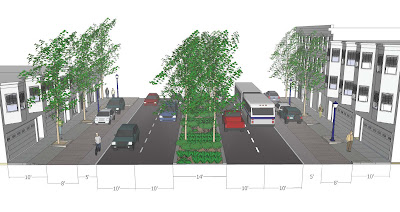I attended last night’s workshop and while the planners did a fine job given their constraints, I think they and the city generally operate in a way to designed to produce mediocre streets and sidewalks. It was clear to everyone that having wide sidewalks was desirable and would solve many problems. The planners see that Chavez is currently built for cars and not humans. They agree this as a problem, using 60 feet of the street’s width for car traffic. I got the impression they would have been glad to make sidewalks wider, which would present, I think, much better small-scale commercial development opportunities that would give some life to the neighborhood. There would be more pedestrians, making the neighborhood safer, commerce more possible, which would bring even more people and more eyes on the street. It’s recursive. It would allow the blocks west of Mission to take advantage of the civic activity on Mission street and improve on their current deserted feel. This vapidity is the result of lack of humans, who don’t like narrow, empty, sidewalks beset by fast traffic. It’s not the lack of trees. The committee, I suspect, knew that was the good way to design an environment for humans.
But wide sidewalks are expensive ($2m/block). They don’t have the funding. And they value consistent street character so they don’t want to widen some but not all.
To a point, I see value in have consistent character along a street. But I fear we decided to make Chavez consistently and permanently mediocre. We could aim higher: build a stretch of the the street we want and finish the rest when funding comes around, whenever that happens (no one has ANY idea, problematically). Just because the PUC is going to do work from Guerrero to Hampshire doesn’t mean they need to extend this project that far, stretching the budget to afford only mediocrity. To those who argue for consistent character, I would point out that Hampshire is an arbitrary boundary to this ‘character’.
Of course, I am anything but prescient in making such points now. From here, the debate will focus on what kind of shrubbery to put in the (15 foot) median. Maybe there is some hope for putting a buffer between the street parking and the bike-lane. I see this as extremely important to the success of the bike lane, and relatively low cost since we have an enormous median from which we can borrow the space. It would also further separate the hypothetical pedestrians from the cars.
After the meeting, I better understand the big problems in the way we build San Francisco. First, this process of presenting posters to concerned citizens favors ideas that make for good sketches. But good urban planning may look terrible on posters while beautiful posters can depict horrible results (e.g. suburbia and urban housing projects look great on posters). There is so much more to good design. It requires us to imagine what the street will feel like for the next thirty years as we build. A median looks good on a poster, but it doesn’t do much to encourage civic life. If no one walks down Chavez, that fat median is in vain at best, and unsavory and neglected at worst. It also guarantees it would be even more expensive to expand the sidewalk in the future (because we would presumably need to narrow the median).
Second, the way the city funds projects–ear-marking cash for a street with no inkling as to when they intend to re-invest in the area–deprives us of a time-horizon for design. IF we knew the city would spend another 10 million in 10 years, we might want to widen half the sidewalks. After-all, in 10 years, the trees in the median won’t yet be in bloom. This process makes us build a mediocre city everywhere rather than a great city somewhere. And we are committed to this mediocrity for the long haul.
But at least we got a bike lane. Bravo to the planners for sticking to that even though it delays construction by a year, precluding the city from using stimulus funds to do this. (Another reason for my personal fatwa on Rob Anderson and his injunction on bicycle improvements.)




No comments:
Post a Comment